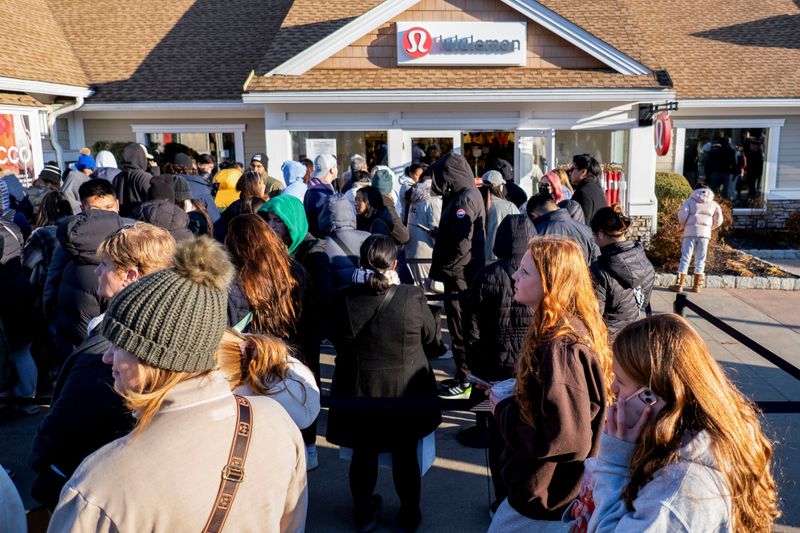By Lucia Mutikani
WASHINGTON (Reuters) - The U.S. economy grew faster than previously estimated in the fourth quarter, boosted by strong consumer spending and business investment in nonresidential structures like factories and healthcare facilities.
The report from the Commerce Department on Thursday also showed profits rising at a solid clip last quarter, driven by nonfinancial corporations. Increasing profits, together with rising worker productivity, could encourage companies to retain their employees, and extend the economic expansion.
The economy has shrugged off fearmongering about a recession following 525 basis points worth of interest rate hikes from the Federal Reserve since March 2022 to quell inflation. Though momentum has slowed, it continues to outpace its global peers.
The report, which also showed underlying inflation pressures easing last quarter, did not change expectations that the U.S. central bank will start cutting rates by June.
"The economy is in good shape," said Bill Adams, chief economist at Comerica (NYSE:CMA) Bank in Dallas. "It is operating on a more even keel than during the pandemic and its immediate aftermath."
Gross domestic product increased at a 3.4% annualized rate last quarter, revised up from the previously reported 3.2% pace, the Commerce Department's Bureau of Economic Analysis said in its third estimate of fourth-quarter GDP.
The revision reflected upgrades in consumer spending, business investment as well as state and local government spending, which offset downgrades to inventory accumulation and exports. Economists polled by Reuters had expected GDP growth would be unrevised.
The economy is growing faster than the 1.8% pace Fed officials regard as the non-inflationary rate of growth. It grew at a 4.9% pace in the July-September quarter, and expanded 2.5% in 2023, an acceleration from 1.9% in 2022. Growth estimates for the first quarter are around a 2.0% pace. The increase in core inflation last quarter was trimmed to a 2.0% rate from a 2.1% pace.
Stocks on Wall Street were little changed ahead of the Good Friday holiday. The dollar rose against a basket of currencies. U.S. Treasury prices were mixed.
CONSUMER SPENDING UPGRADED
Consumer spending, which accounts for more than two-thirds of U.S. economic activity, increased at a 3.3% rate, adding 2.20 percentage points to GDP growth. It was previously estimated to have grown at a 3.0% pace. The upward revision was in services.
The upgrade to business spending reflected higher outlays on manufacturing as well as commercial and healthcare structures than previously estimated. Spending on intellectual property products was also revised up, while the decline in outlays on equipment was not as steep as previously estimated.
Inventory investment was lowered to a $54.9 billion rate from the previously estimated $66.3 billion pace. While that subtracted 0.47 percentage point from GDP growth, the outlook for this year is encouraging. Stronger consumer spending last year and expectations for a moderation this year likely resulted in the slower pace of inventory accumulation.
"We anticipate that inventory accumulation will stabilize, then begin to pick up again over the next few years," said Michael Pearce, deputy chief U.S. economist at Oxford Economics in New York. "That turn in the inventory cycle will help support GDP growth this year and make the slowdown gradual."
Nearly all industries contributed to growth last quarter, with nondurable goods manufacturing leading the charge, followed by retail trade, durable goods manufacturing and healthcare and social assistance. But agriculture, wholesale trade and arts, entertainment and recreation were minor drags.
Corporate profits including inventory valuation and capital consumption adjustments increased $133.5 billion after rising $108.7 billion in the July-September quarter. Profits of domestic nonfinancial firms increased $136.5 billion, while those of financial institutions rose $5.9 billion, more than offsetting an $8.9 billion decline in profits from the rest of the world. Profit margins were solid.
"While firms have generally pulled back on making large capital expenditures, decent year-end profitability suggests businesses entered 2024 in adequate financial shape," said Shannon Grein, an economist at Wells Fargo in Charlotte, North Carolina. "To the extent continued profitability enables hiring, spending could be sustained."
Higher profits together with fairly strong wage gains boosted the income side of the growth ledger. Gross domestic income (GDI) grew at a robust 4.8% rate after increasing at a 1.9% pace in the July-September quarter.
In principle, GDP and GDI should be equal, but in practice differ as they are estimated using different and largely independent source data. The sharp narrowing in the gap between GDP and GDI should assuage concerns that the economy's health was being overstated.
The average of GDP and GDI, also referred to as gross domestic output and considered a better measure of economic activity, increased at a 4.1% rate last quarter after advancing at a 3.4% pace in the third quarter.
A separate report from the Labor Department showed initial claims for state unemployment benefits fell 2,000 to a seasonally adjusted 210,000 for the week ended March 23. Economists had forecast 212,000 claims in the latest week.
Claims have been hovering in a 200,000-213,000 range since February despite a rash of high-profile layoffs at the start of the year.
The number of people receiving benefits after an initial week of aid, a proxy for hiring, increased 24,000 to 1.819 million during the week ending March 16, the claims report showed. The so-called continuing claims covered the period during which the government surveyed households for March's unemployment rate.
Continuing claims were little changed between the February and March survey periods. The unemployment rate was at 3.9% in February.
"The labor market is becoming better balanced between demand for and supply of workers, which will help moderate upward wages pressures," said Stuart Hoffman, senior economic advisor at PNC Financial (NYSE:PNC) in Pittsburgh, Pennsylvania.
